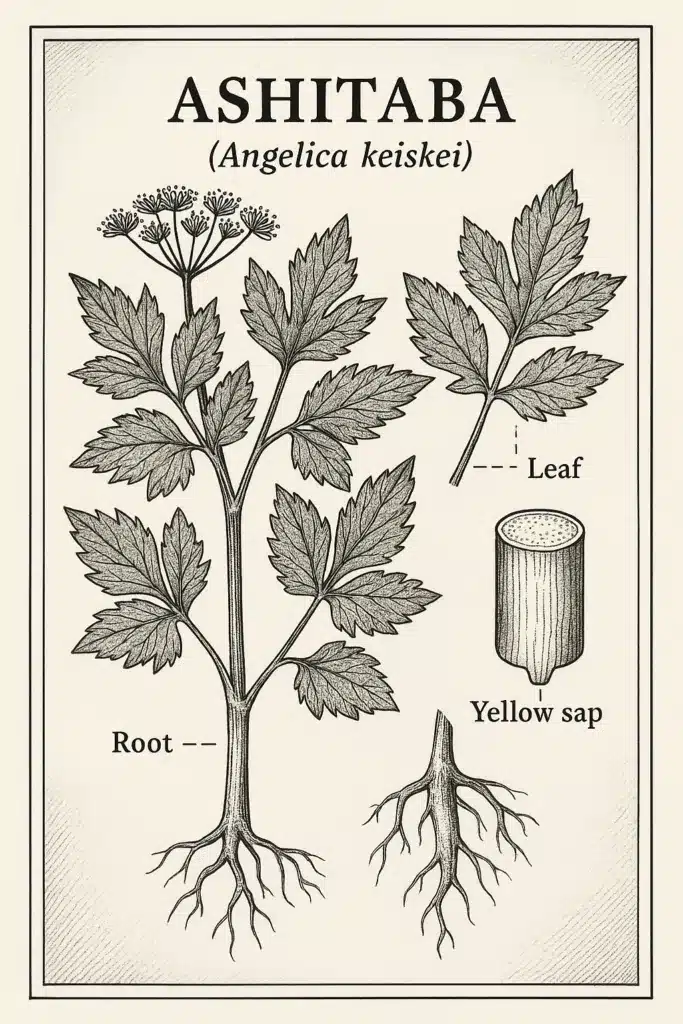Angelica Keiskei (Ashitaba)
Angelica keiskei (Miq.) Koidz. — Materia Medica

Snapshot
Preclinical studies of Ashitaba’s chalcones (xanthoangelol, 4-hydroxyderricin) show antioxidant and anti-inflammatory activity and explore metabolic pathways for glucose and lipids. Human trials remain limited, so Ashitaba is best framed as a nutrient-dense food herb with gentle digestive support.Introduction
Ashitaba (Angelica keiskei) is a leafy perennial in the carrot family (Apiaceae) native to Japan’s Izu and Bōsō peninsulas. Its name—“tomorrow’s leaf”—reflects how quickly new shoots appear after harvesting. Used traditionally as a nutritive food herb and kitchen remedy, Ashitaba is rich in polyphenols (notably chalcones like xanthoangelol and 4-hydroxyderricin), coumarins, and flavonoids. Contemporary interest centers on digestive comfort, metabolic wellness, and general antioxidant support.
Botanical profile
-
Scientific name: Angelica keiskei (Miq.) Koidz.
-
Common names: Ashitaba, Tomorrow’s Leaf, Angelica Keiskei
-
Family: Apiaceae (carrot/parsley family)
-
Parts used: Leaves and young stems (food/tea); root used traditionally in smaller amounts.
-
Habitat & ID: Perennial to ~50–100 cm; hollow green stems; large, shiny, deeply divided leaves; white umbel flowers in summer. Distinctive yellow sap exudes when cut (source of chalcones).
Traditional uses
-
Nutritive leafy vegetable in soups, stir-fries, tempura, and teas.
-
Household herb for digestive upset, gentle detox/regularity, and everyday vitality.
-
Topical poultices historically used for minor skin irritation.
Constituents & actions (overview)
-
Chalcones: xanthoangelol, 4-hydroxyderricin → antioxidant, anti-inflammatory (preclinical).
-
Coumarins & furanocoumarins (trace): aromatics typical of Angelica species.
-
Flavonoids & polysaccharides: general antioxidant and tonic effects.
Primary herbal actions (traditional + emerging):
anti-inflammatory, antioxidant, digestive (digestant/carminative), hepatoprotective (emerging), hypoglycemic (emerging), mild immunomodulatory (emerging).
Evidence note: Much of the mechanistic evidence is preclinical (in vitro/animal). Human trials are limited; position Ashitaba primarily as a food-level herb.
Potential benefits (food-herb framing)
-
Digestive comfort: warm infusions or lightly cooked leaves can settle a heavy stomach; bitters/aromatics may support bile flow and appetite regulation.
-
Metabolic wellness (emerging): early research on chalcones explores impacts on glucose and lipid pathways.
-
Liver support (emerging): antioxidant activity and bile support are of interest; human data limited.
-
General vitality: mineral-rich leafy green with culinary versatility.
Preparations & use
-
Culinary (preferred): sautéed greens, soups, tempura; add late to preserve aromatics.
-
Tea (infusion): 1–2 tsp dried leaf (or 2–3 tsp fresh) per 8 oz just-off-boil water; steep 10–12 min, up to 3×/day as needed.
-
Powder/capsules: standardized products exist; follow maker’s directions.
-
Tincture (leaf): 2–4 mL (1:5, 40–50% EtOH) up to 3×/day; food use preferred.
Safety & contraindications
-
Generally food-level safe when used as a vegetable or tea.
-
Apiaceae allergy: avoid if sensitive to celery, parsley, or carrot family plants.
-
Pregnancy/lactation: limited safety data in concentrated forms—prefer culinary amounts.
-
Medications: because Angelica species contain coumarin-type constituents, use caution with anticoagulant/antiplatelet drugs; monitor with a clinician.
-
Discontinue if rash or GI upset occurs.
-
This information is educational and not medical advice.
Identification & harvest notes
Cut leaves in the morning; plants often resprout the next day. Look for the yellow sap at cut surfaces. Prefer young, tender leaves; avoid roadside/contaminated areas.
Related herbs (compare/contrast)
-
Angelica archangelica (European Angelica) — stronger aromatic bitter; more classical carminative.
-
Dong quai (Angelica sinensis) — TCM women’s health herb; not culinary.
-
Dandelion — nutritive bitter green and liver support.
Identification & Harvest
Perennial with glossy, divided leaves; yellow sap at cut surfaces; quick regrowth after cutting. Harvest young leaves and tender stems; dry in thin layers or use fresh.Preparations
- tea-infusion
- tincture
- glycerite
- powder
- capsule
Safety
Food-level use is generally well tolerated. Avoid with Apiaceae allergy. Limited data for pregnancy/lactation—prefer culinary amounts. Use caution with anticoagulant/antiplatelet drugs. Stop if rash/GI upset occurs.Related Research
No studies yet.
References
- (2003) Chalcones, coumarins, and flavanones from the exudate of Angelica keiskei and their chemopreventive effects
- (2006) Chalcones and other compounds from the exudates of Angelica keiskei and their cancer chemopreventive effects
- (2011) 4-Hydroxyderricin from Angelica keiskei roots induces caspase-dependent apoptotic cell death in HL60 human leukemia cells
- (2005) Xanthoangelol…induces apoptosis in neuroblastoma and leukemia cells
- (2018) The Ashitaba (Angelica keiskei) chalcones 4-hydroxyderricin and xanthoangelol suppress melanomagenesis
- (2020) 4-Hydroxyderricin and xanthoangelol…prevent dexamethasone-induced muscle loss
- (2024) Two prenylated chalcones (4-HD & XAG) prevent postprandial hyperglycemia via LKB1/AMPK
- (2017) (Broader herb review) Angelica keiskei, an emerging medicinal herb…
Educational content only; not medical advice.
